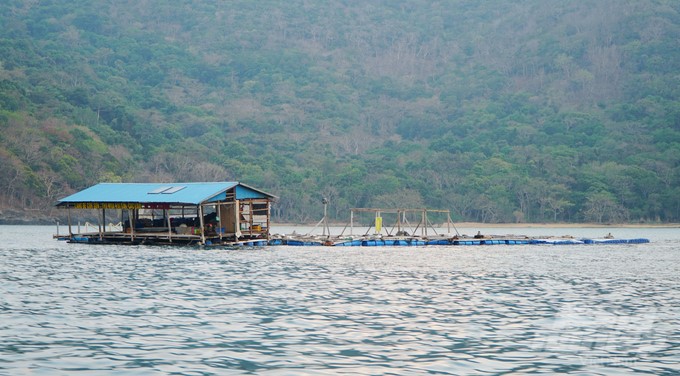May 30, 2025 | 05:08 GMT +7
May 30, 2025 | 05:08 GMT +7
Hotline: 0913.378.918
May 30, 2025 | 05:08 GMT +7
Hotline: 0913.378.918

"Oyster island" and Long Son caged fish. Photo: Le Binh.
Long Son island commune at the Cha Va river estuary (Vung Tau city) is known as the "kingdom" of oysters. This place is considered an "oyster granary" supplying the Southeast market. Long Son oyster is not only rich in meat, delicious, and fatty, but also rich in nutrition, safe, and hygienic.
It is estimated that in Long Son commune alone, there are more than 300 farming facilities with nearly 14,000 farming cages on the Cha Va, Dinh, and Rang rivers. Many aquatic species have high economic value, such as oyster, cobia, snubnose pompano, and pearl grouper. Output is estimated at over 20,000 tons/year.
Among them, oyster is the main species raised in cages here. Each crop, an oyster farming household can harvest 50–60 tons of whole shelled oysters. The selling price fluctuates around VND 20,000–22,000/kg. After deducting all costs, farmers still earn about 40% of total revenue.
Mr. Nguyen Quy Trong Binh, Director of Nhu Y Long Son Cooperative, said that the unit is researching and investing in technology to process oysters for takeaway sales and export.
In recent years, Long Son has also been known as an attractive ecotourism destination of Ba Ria-Vung Tau. Nhu Y Long Son Cooperative has put into operation a culinary and resort area on the river, right in the farming area near the foot of Cha Va bridge.

The Nhu Y Raft Village tourist and culinary area on the Cha Va river. Photo: Le Binh.
Coming here, tourists will visit the aquaculture area on the river and experience raising oysters and fish of all kinds. In addition to directly enjoying the seafood here, tourists can experience standup paddleboarding services, stay overnight, etc.
Vung Tau city is also planning to open source tours in Long Son island commune with three highlights: Long Son Big House, salt-making experience, and sightseeing and enjoying cuisine on the Cha Va river.
"With this model, Nhu Y Long Son Cooperative is well performing the consumption of aquaculture products while attracting tourists and creating tourist highlights. The model not only contributes to promoting the local economy but also promotes responsible agriculture for the province," said Ms. Tran Thi Thu Huong, Head of Vung Tau City Economics Department.
Ba Ria-Vung Tau is assessed as a place with diverse farming objects and areas. Blessed by nature, the province has about 306 km of coastline, mainly beaches. Many locations are very suitable for marine farming.
However, currently, there are only six households doing marine farming with an area of 2 hectares in Ben Dam Bay area, Con Dao district. The main aquatic species raised by these six households are grouper, cobia, pomfret, ornate spiny lobster, slipper lobster, etc. Seafood here is usually harvested after 4–8 months.

Currently, Ba Ria-Vung Tau has six marine farming households in Con Dao with a total area of 2 hectares. Photo: Le Binh.
According to Mr. Le Van Phong, Chairman of the Con Dao District People's Committee, these marine farming households must commit to using fish food made entirely from 100% natural trash fish and not using industrial food or chemicals in the farming process in existing rafts.
"The district pays special attention to the marine tourism economy associated with conservation and the farming for marine seafood exploitation, which does not conflict with the environment. This is a big problem, so it is being studied and evaluated overall," Mr. Phong shared.
Many fisheries experts assume that Ba Ria-Vung Tau needs to increase marine farming to be worthy of favorable conditions and supplement the output of the declining fishing sector.

Mr. Le Van Quan's household is using cages made from HDPE material combined with roofs in marine farming. Photo: Le Binh.
Talking with reporters from Vietnam Agriculture Newspaper, Mr. Nguyen Huu Thi, Deputy Director of the Provincial Sub-Department of Fisheries, said that Ba Ria-Vung Tau develops an integrated ocean economy, so it is difficult to expand the farming area and region.
"The number of fishing vessels transporting goods into and out of ports is quite large, which greatly affects marine farming. Marine farming must be in harmony with tourism and national security issues, so it needs to be carefully calculated, focused, and sustainable," Mr. Thi said.
Marine farming in Ba Ria-Vung Tau is oriented to be in association with absolute environmental protection and must be combined with tourism to aim for marine ecotourism. Tourists can come and check-in at these types of aquaculture.
Translated by Thu Huyen
/2025/05/25/4127-3-073637_820.jpg)
(VAN) Thanks to the promotion from an FAO-implemented project, vegetable production in greenhouses in Moc Chau has seen strong development, from 1.5 hectares in 2021 to nearly 50 hectares in 2024.

(VAN) FAO has recently supported USD 140,000 to implement the project 'Risk mitigation human-animal interface risks through disease control initiatives in pig farming.'

(VAN) The People's Committee of Tra Vinh province has approved an adjustment to the investment policy for the Green Hydrogen Plant project, increasing its area to approximately 52.76 hectares.
![Reducing emissions from rice fields: [2] Farmers’ commitment to the soil](https://t.ex-cdn.com/nongnghiepmoitruong.vn/608w/files/news/2025/05/05/dsc08881jpg-nongnghiep-140632.jpg)
(VAN) Clean rice cultivation model in Thuong Tan commune, Bac Tan Uyen district, is assisting local residents in achieving sustainable agriculture by substantially reducing costs, increasing productivity, and protecting the environment.

(VAN) At the conference to disseminate Resolution No. 68, AgriS introduced its digital agricultural ecosystem and reaffirmed its commitment to accompanying the Government in promoting private sector development and sustainable agriculture.

(VAN) 'Blue Ocean - Blue Foods' initiative is designed to restore marine ecosystems and establish sustainable livelihoods for local communities by cultivating a minimum of 1,000 hectares of cottonii seaweed in the first three years.
/2025/05/21/4642-3-112707_603.jpg)
(VAN) The V-SCOPE project has made direct contributions to three out of six pillars of the Comprehensive Strategic Partnership between Vietnam and Australia.